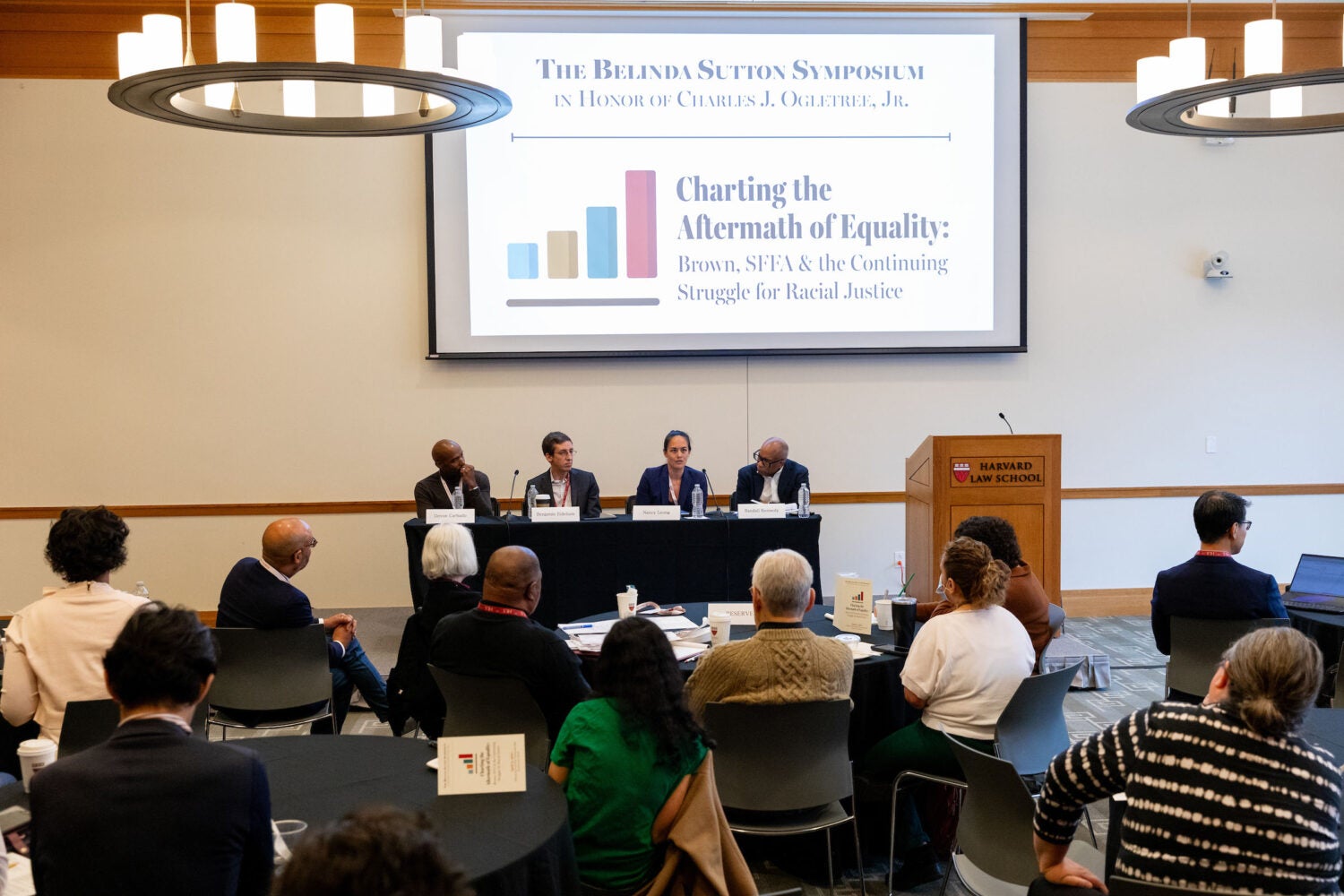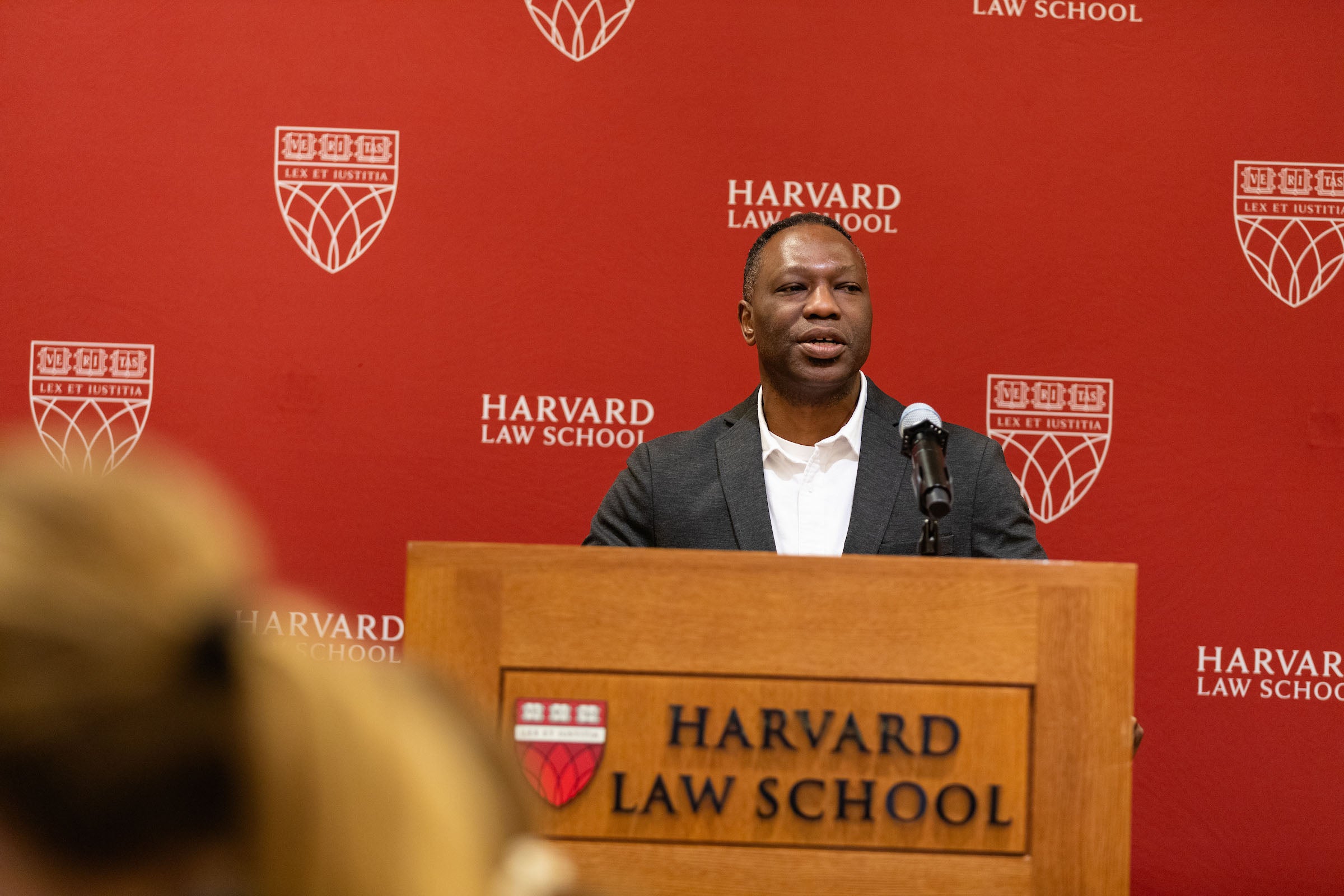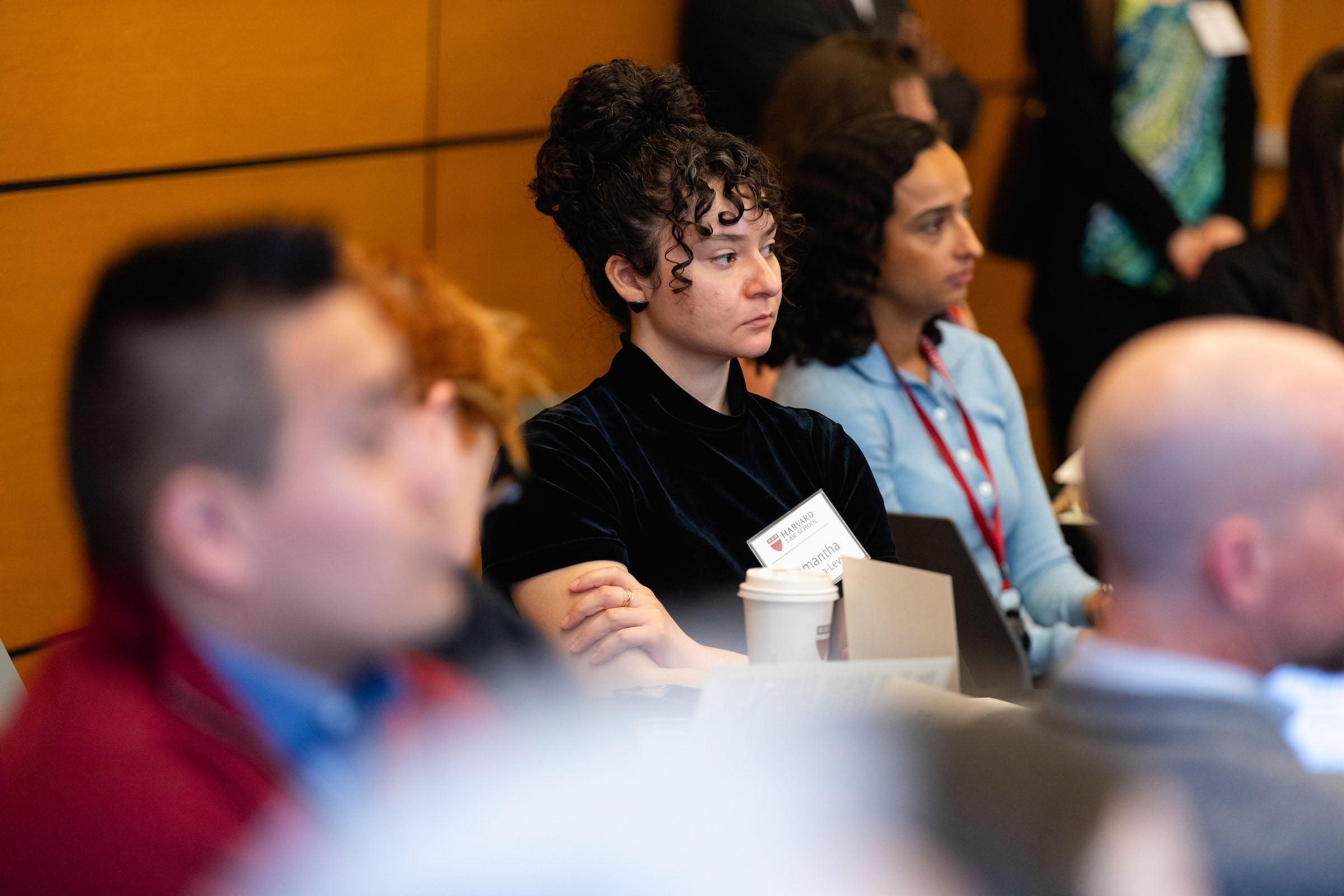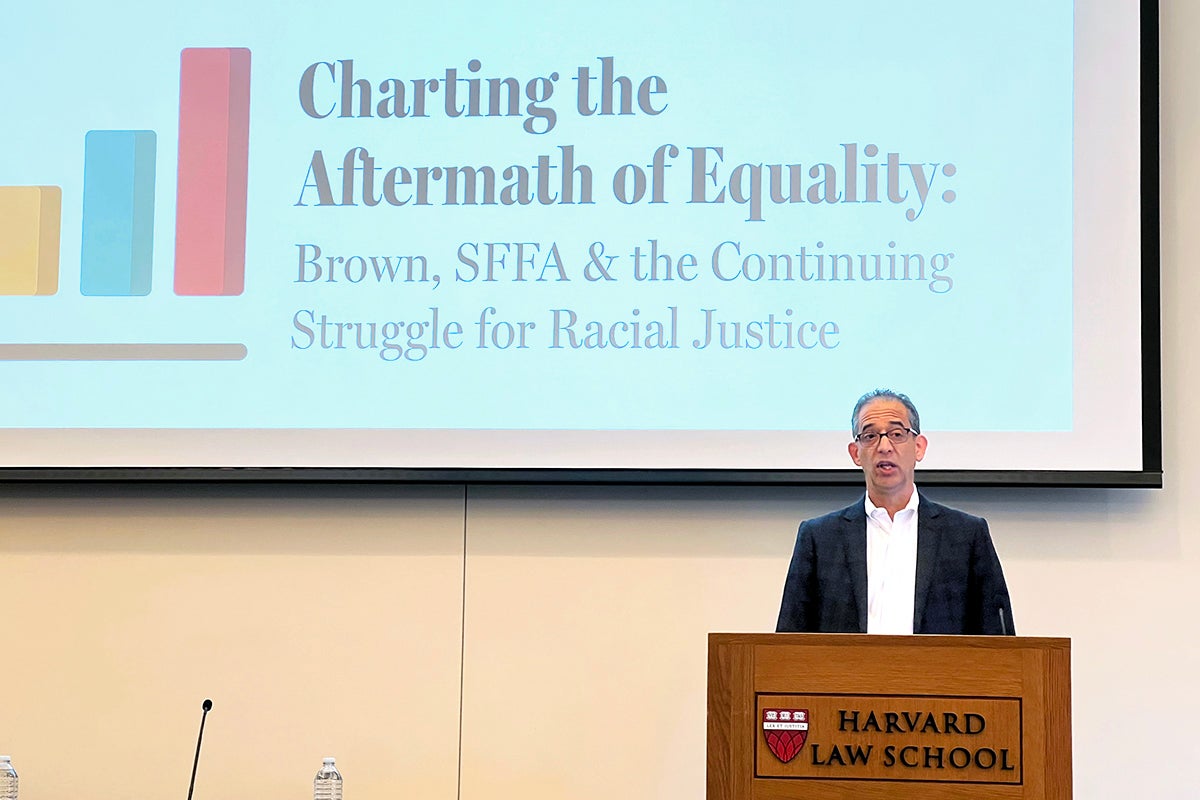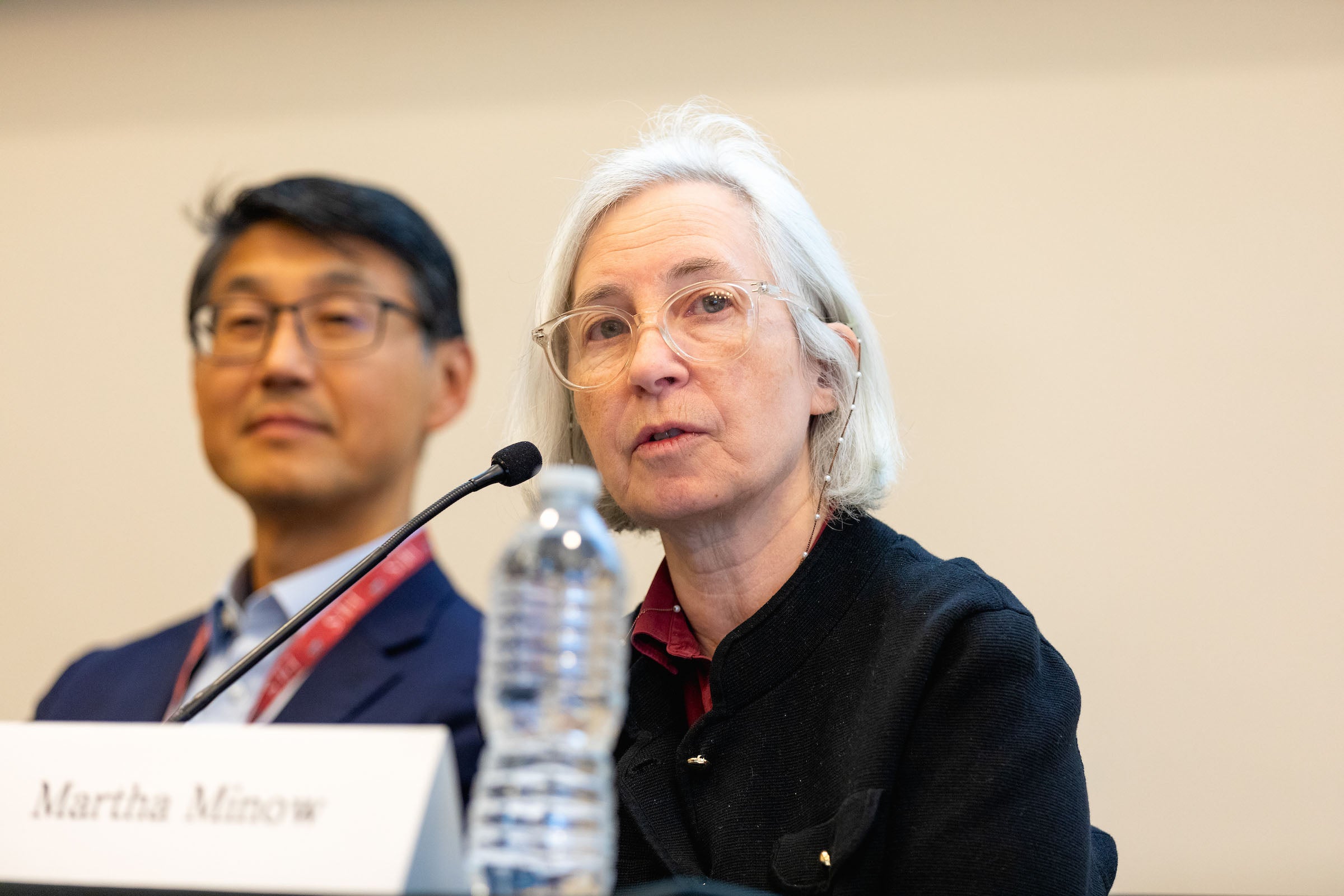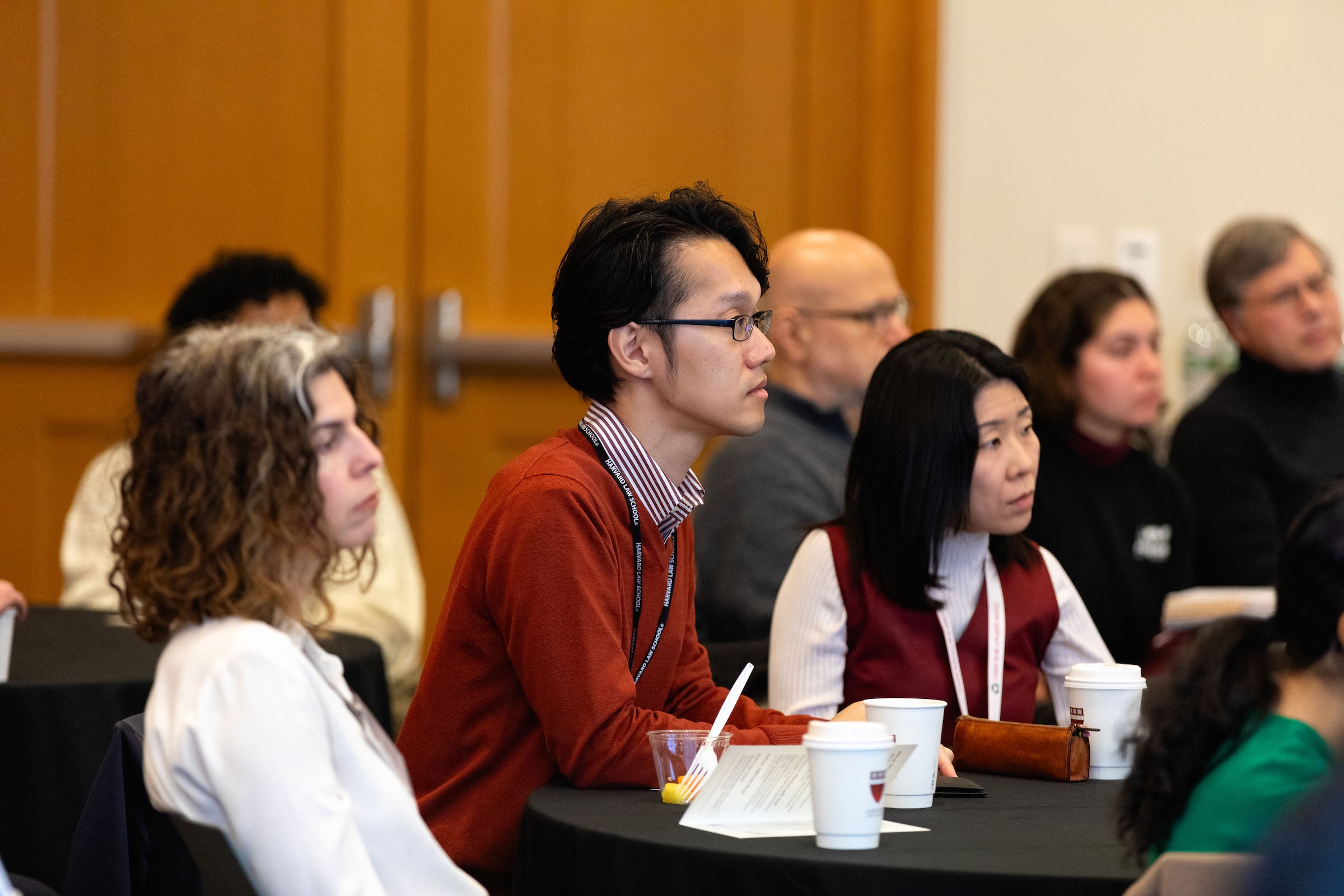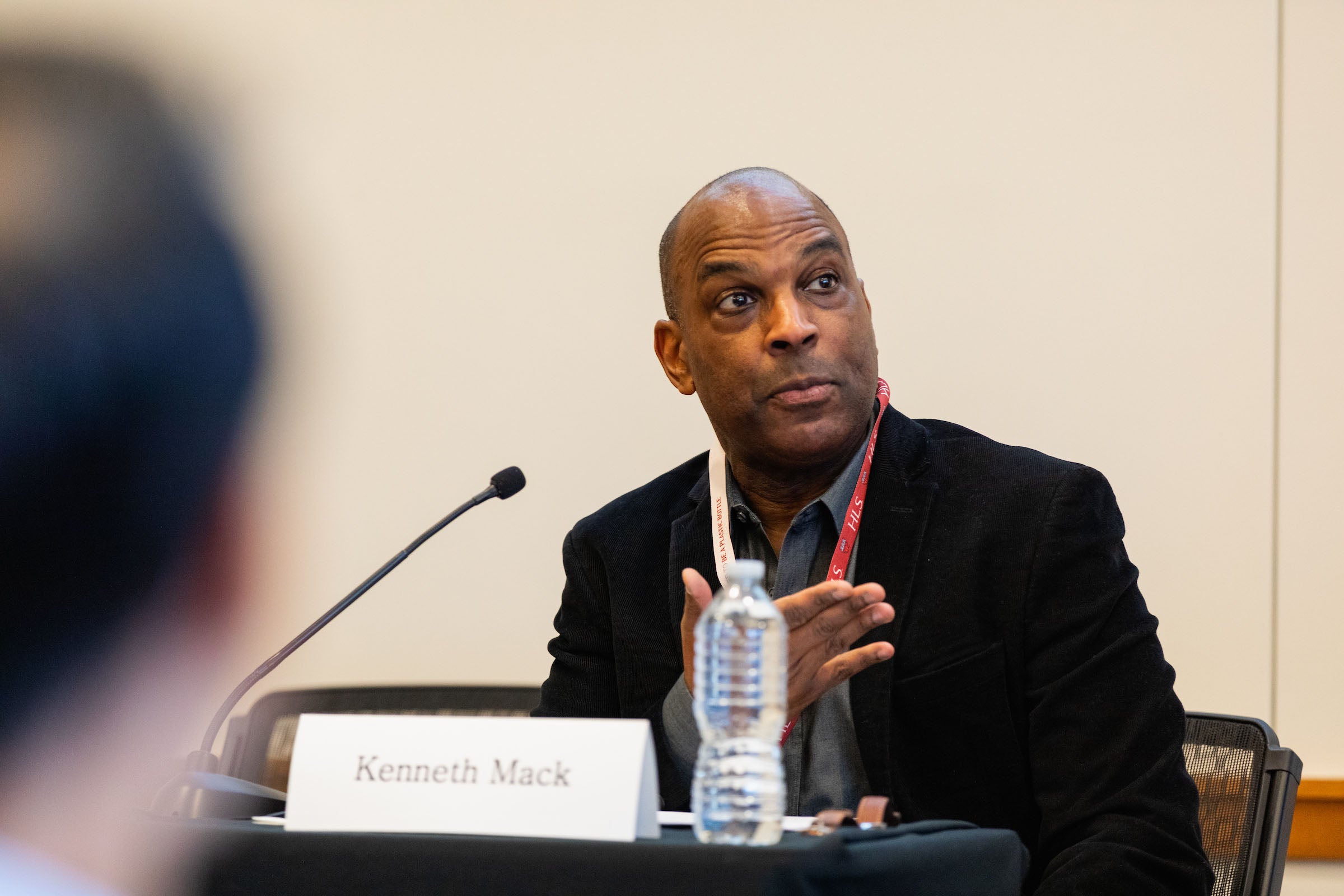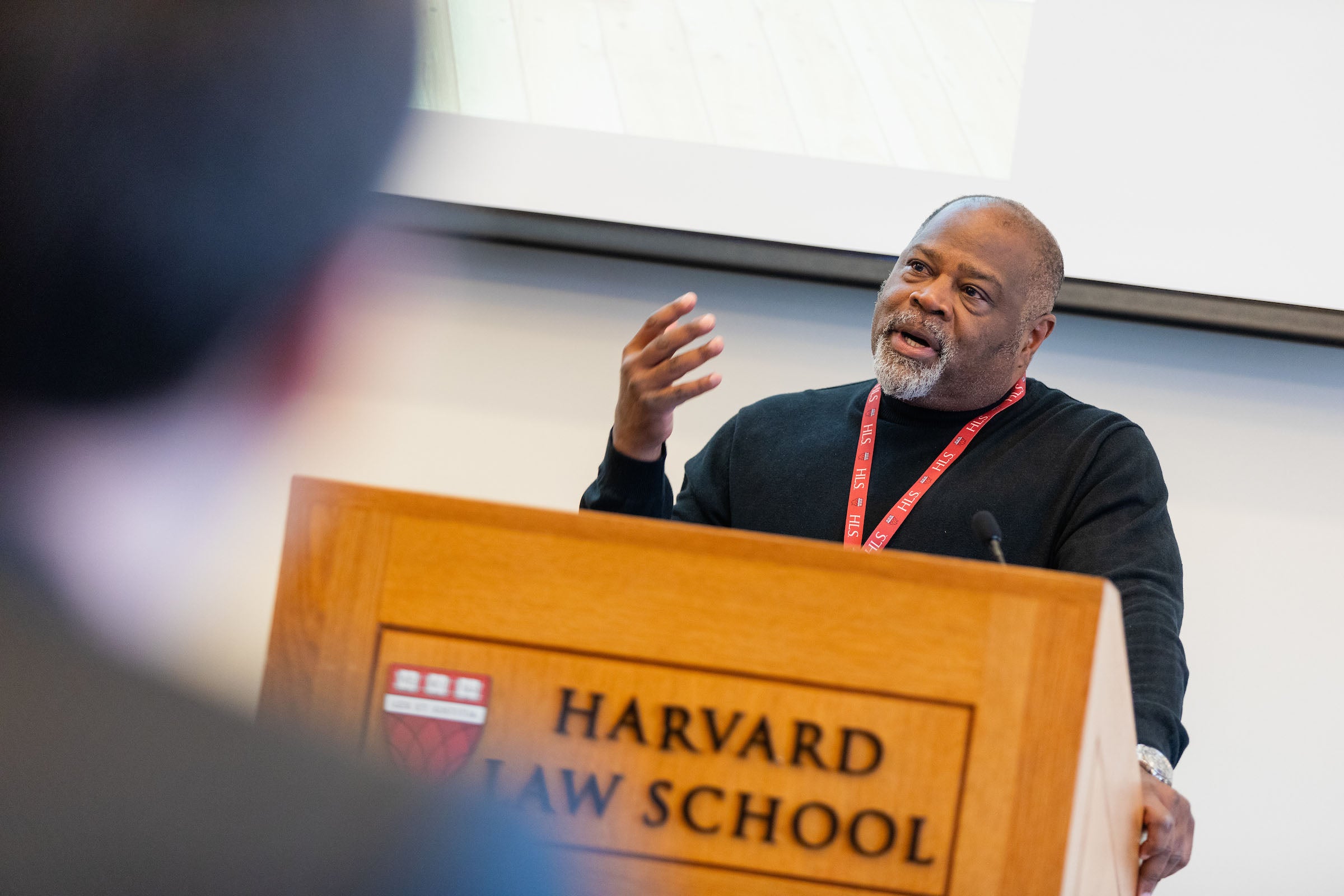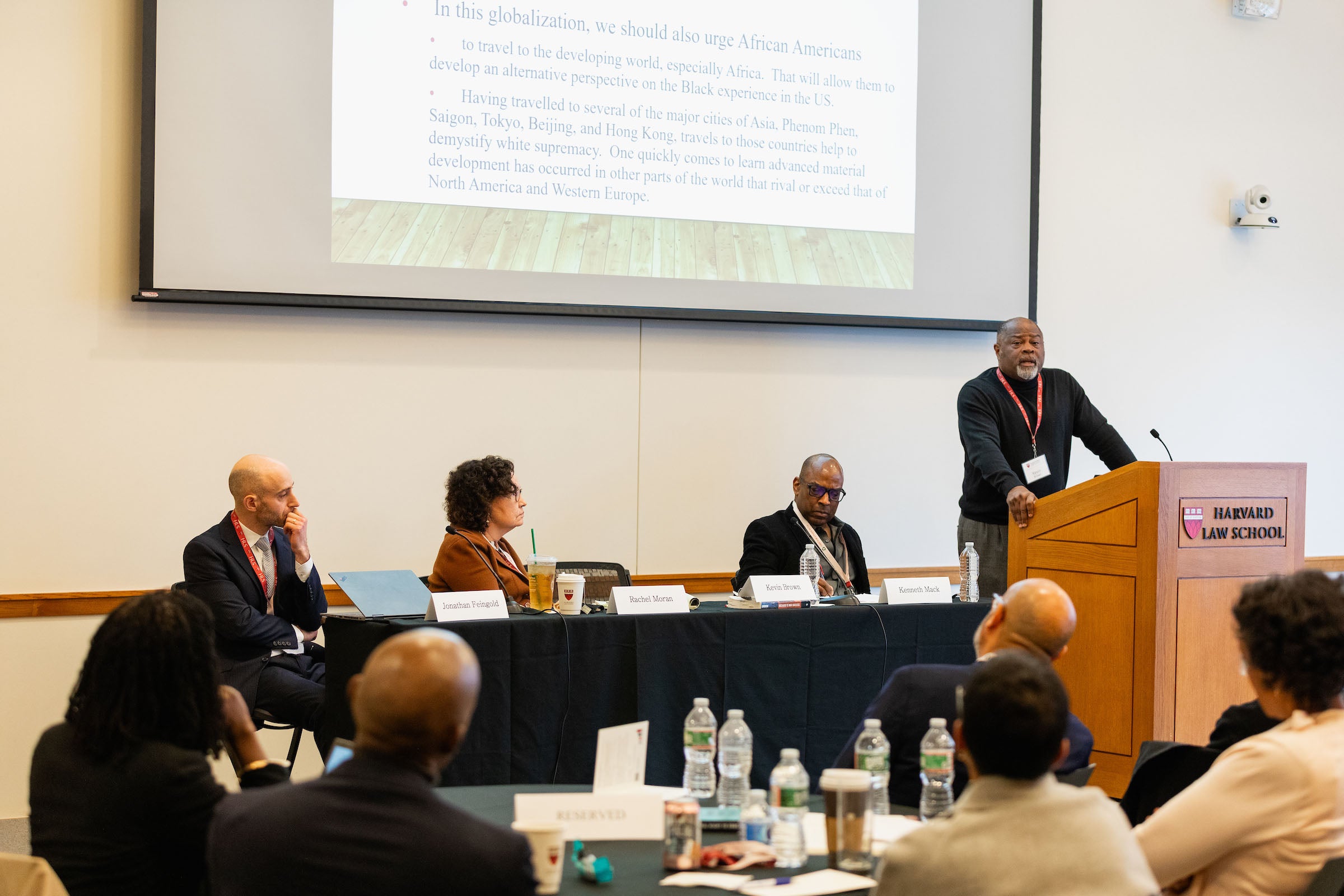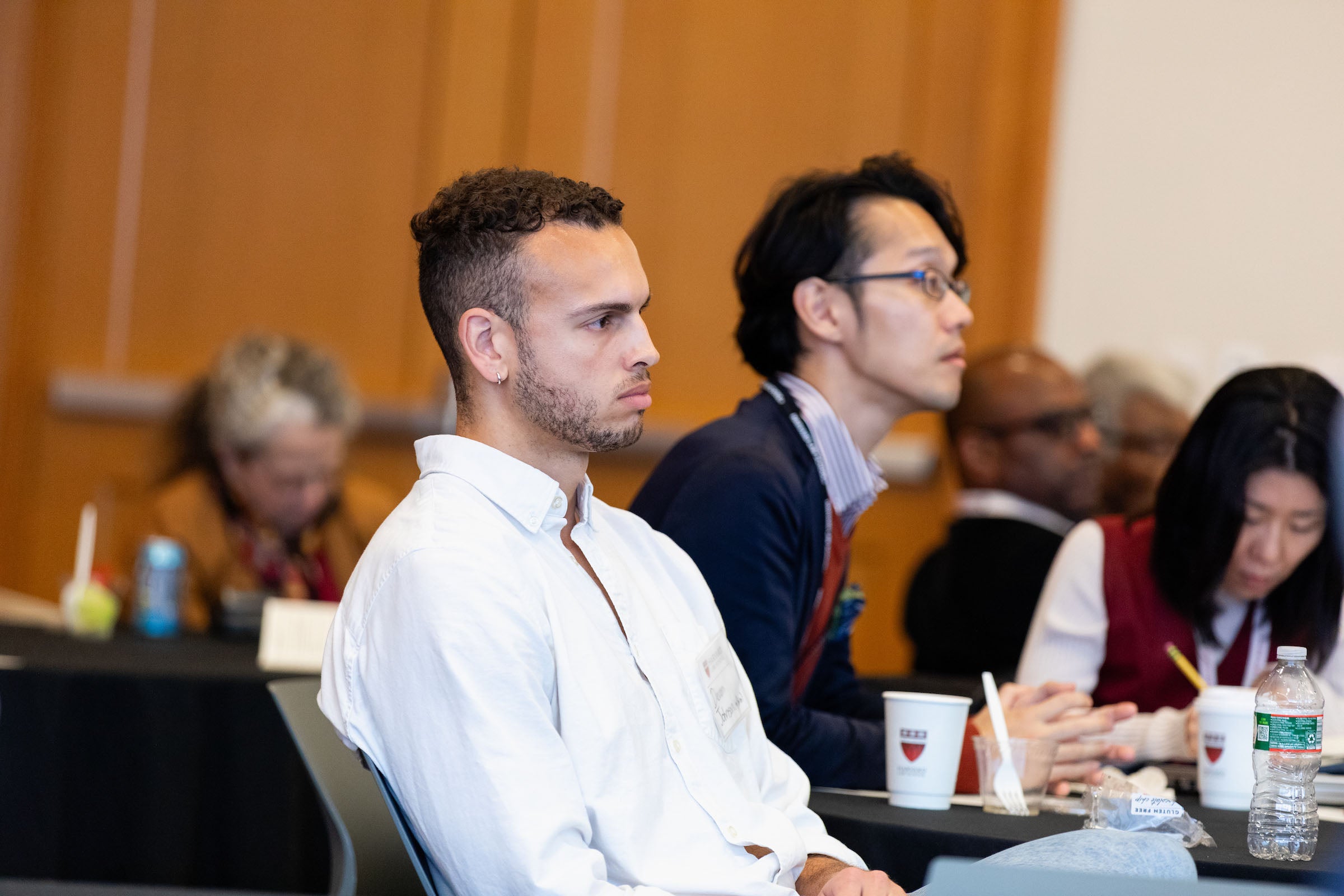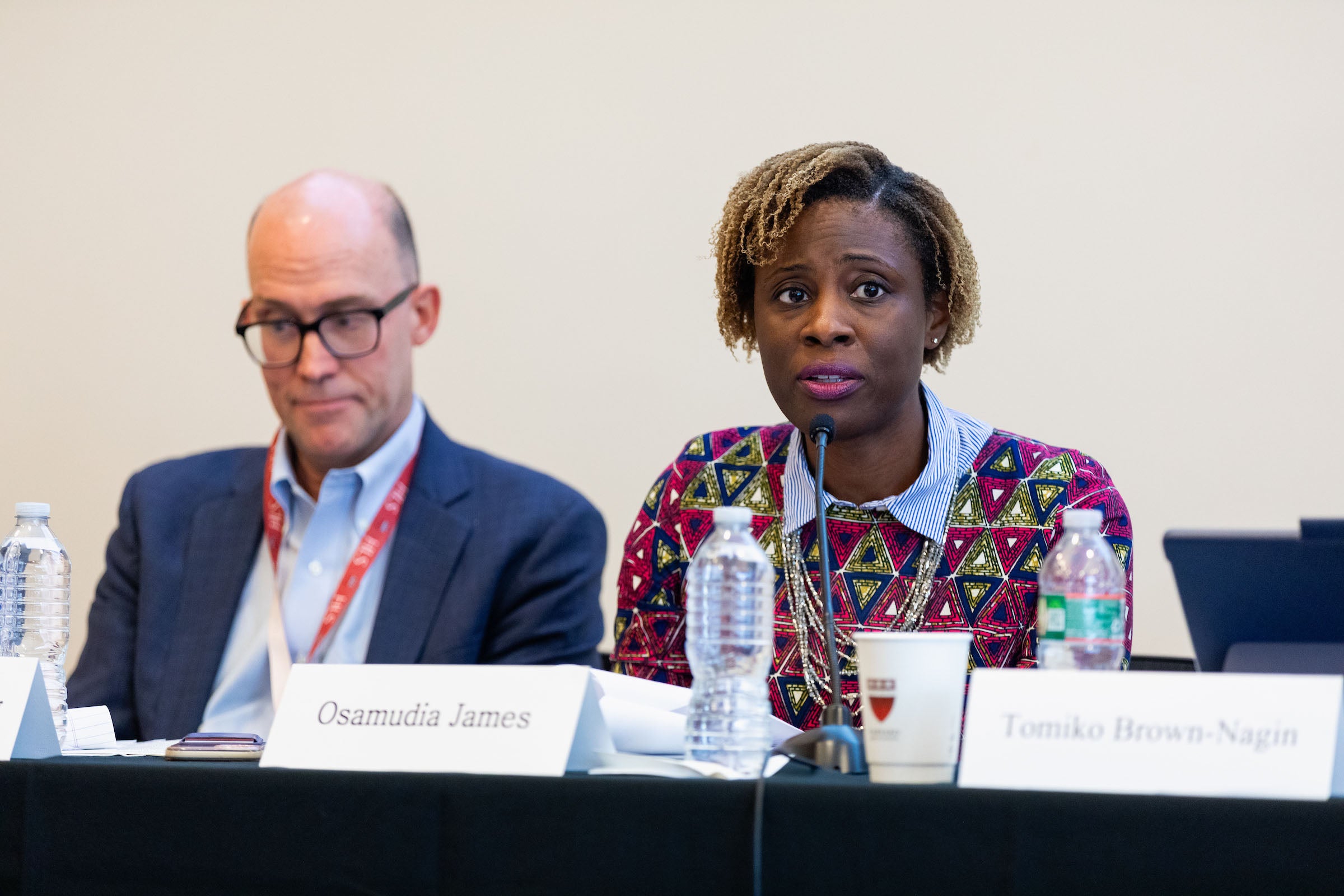Although the United States Supreme Court’s 1954 decision in Brown v. Board of Education has often been considered “the greatest case in 20th century constitutional law,” legal historian and constitutional law expert Tomiko Brown-Nagin recently pronounced herself as “conflicted about these claims.”
“Why?” asked Brown-Nagin, dean of the Radcliffe Institute for Advanced Study. “Because I’m afraid that the rhetorical significance we attach to Brown is overstated — a partial truth at best, and a way of convincing ourselves that we are better than the evidence shows we actually are regarding matters of race and inequality.”
Her comments came during a day-long series of discussions and presentations at Harvard Law School titled, “Charting the Aftermath of Equality: Brown, SFFA & the Continuing Struggle for Racial Justice.” The April 11 gathering marked the inaugural Belinda Sutton Symposium, an annual lecture and conference series honoring Belinda Sutton, a woman who was enslaved by Isaac Royall Jr., whose 1781 bequest to Harvard College funded a professorship that helped to establish Harvard Law in 1817.
Established by Dean John F. Manning ’85 in 2022, the series is organized by Guy-Uriel E. Charles, the Charles J. Ogletree Jr. Professor of Law and faculty director of the Charles Hamilton Institute for Race and Justice. The series launched in 2022 with the first Belinda Sutton Distinguished Lecture.
As Interim Harvard Law Dean John C. P. Goldberg explained in welcoming remarks, the event was also dedicated to the memory and legacy of Professor Charles J. Ogletree, Jr. ’78, who passed away last year.
“Professor Ogletree’s hugely important and influential work as an educator and mentor to generations of students, his establishment of the [Charles Hamilton Houston] Institute, and his active participation in litigation and public debates over issues of racial justice are an inspiration to anyone concerned with the challenges we face in moving toward justice and equity,” Goldberg said. “Deservedly, Tree’s life and work will continue to shape this law school for generations to come.”
Brown v. Board of Education: ‘A deeply contested decision’
A full 70 years after nine white male justices voted unanimously to ban de jure racial segregation in American schools, overturning the 1896 “separate but equal” Plessy v. Ferguson precedent, Brown-Nagin argued that “the meaning of this case is deeply contested.” Some say Brown v. Board created a fundamental law, others that “it’s just politics.” Some see it as standing for “colorblindness,” while others see it as requiring “equal educational opportunity.”
“All of this is to say that it is only in a most narrow, formal sense that Brown and its meaning have been immune to questioning,” said Brown-Nagin, who is also the Daniel P.S. Paul Professor of Constitutional Law at Harvard Law School. “We don’t even know what the case means, or what we want it to mean. The only educational principle that we can all agree that Brown stands for is that it is unconstitutional for states to enact statutes that on their face mandate racial segregation. That’s it!”
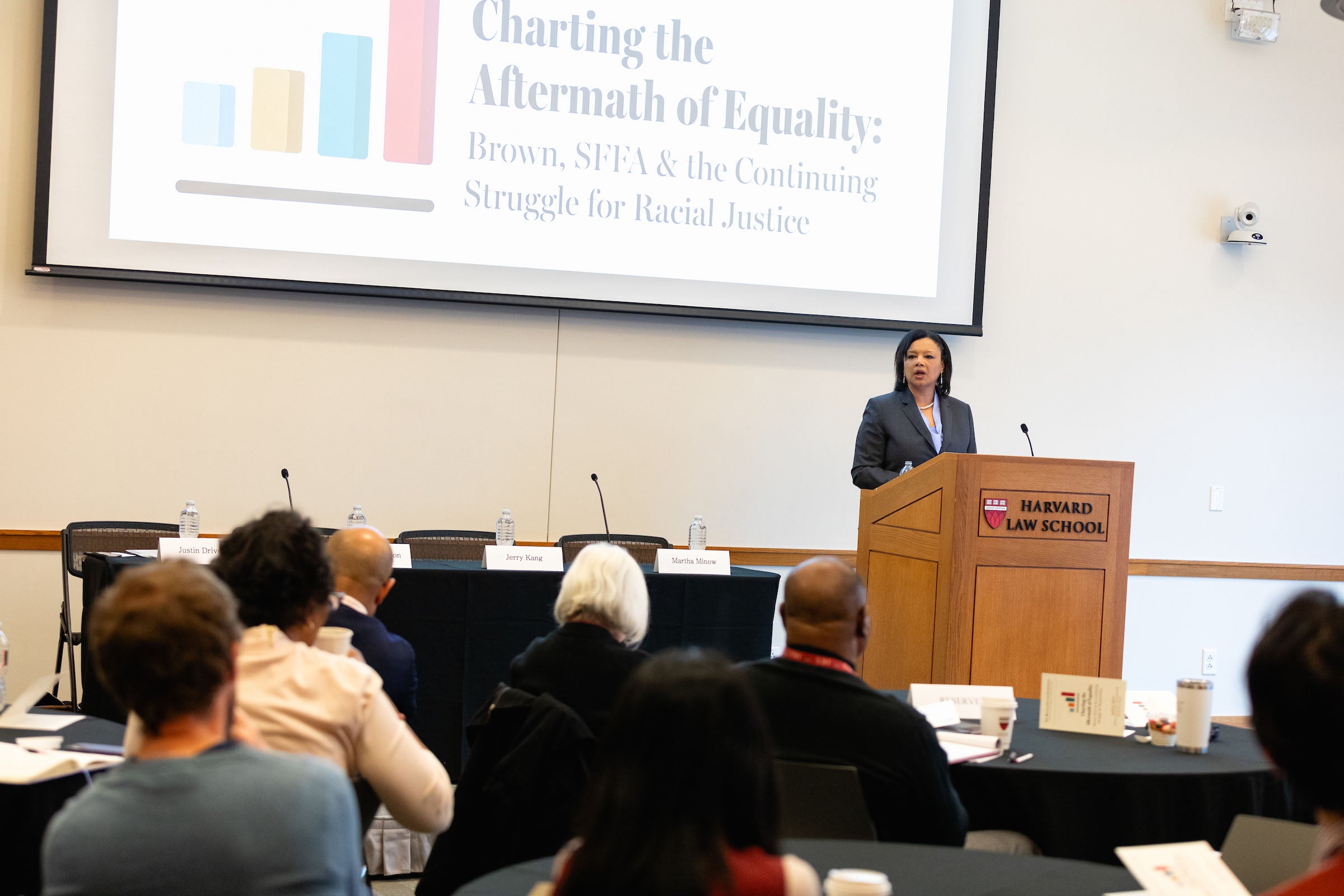
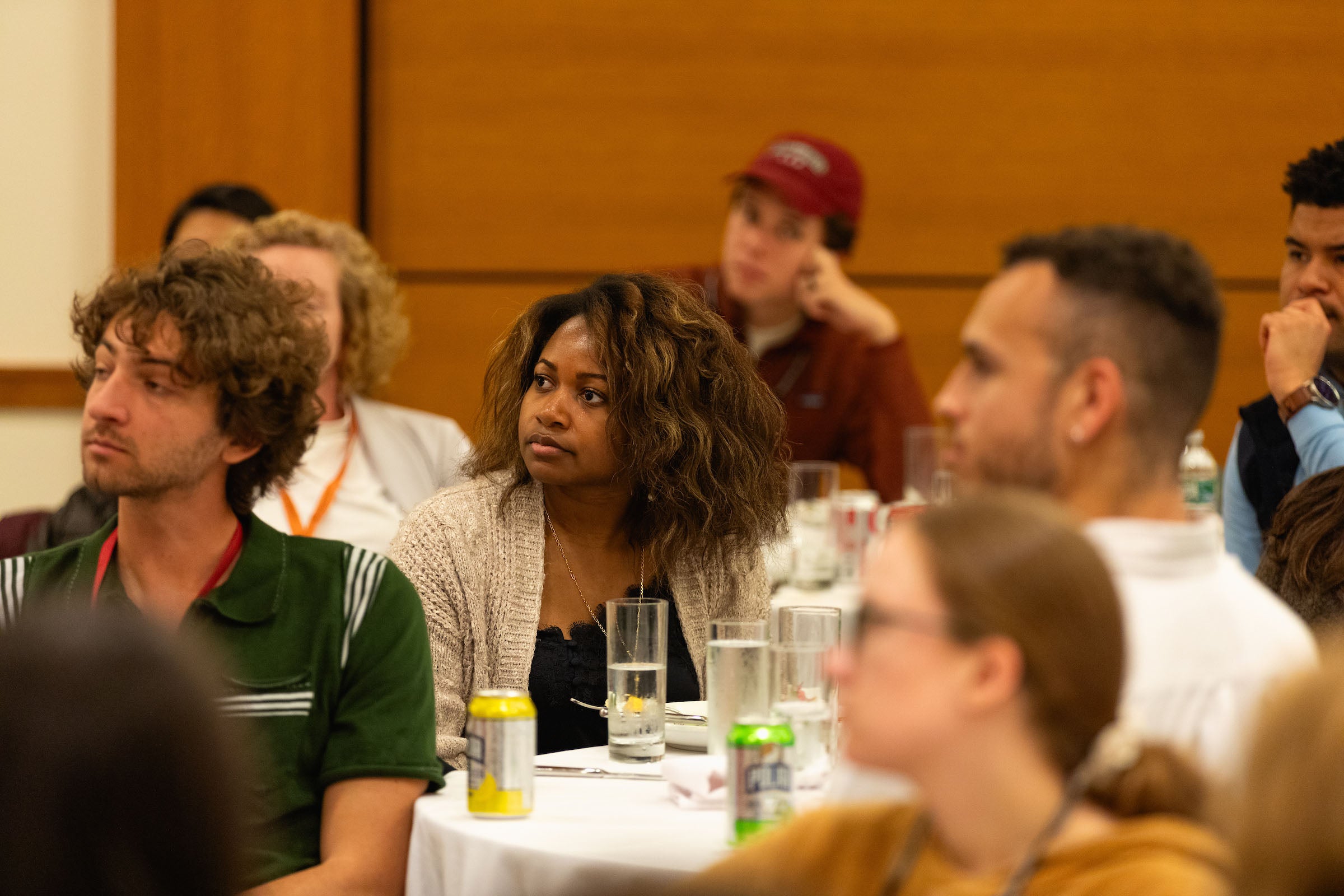
And even that view was never accepted by some white opponents, particularly in Southern states, who resorted to violence to maintain segregation. “Never forget,” Brown-Nagin reminded the audience, “that it took federal troops to desegregate schools in Little Rock, Arkansas.”
While passage by Congress of the Civil Rights Act in 1964, combined with several Supreme Court decisions under Chief Justices Earl Warren and Warren Burger, eventually spurred progress towards integrating schools, she argued, the tide turned again near the end of the Reagan administration. “School desegregation peaked in 1988,” Brown-Nagin said, citing research from UCLA’s Gary Orfield. “There have been no major legal or policy advances since that time, 36 years ago … Since then, resegregation has been the trend.”
And according to Brown-Nagin, the Court has recently aided the retrenchment of educational segregation. Notwithstanding Chief Justice John Roberts’ famous claim in the 2007 opinion he authored in Parents Involved v. Seattle School District No. 1 that, “[t]he way to stop discrimination on the basis of race is to stop discriminating on the basis of race,” research by Harvard economist Raj Chetty, she said, shows that a “student’s zip code is strongly correlated with life chances,” and people living in racially segregated areas “tend to have low upward mobility from one generation to the next.”
In other words, the Court’s recent turn to a “colorblind” approach to the law, she believes, is enabling de facto segregation to flourish at the expense of underrepresented minority communities.
But Brown-Nagin concluded her remarks on a note of optimism. “I would like to remind everyone that there is opportunity in every challenge,” she said. “This is not a time for hopelessness or failures of imagination. It is time for resilience and ingenuity.”
“I, for one, am a passionate believer in education as a path to social mobility and equal opportunity,” she said. “And I am an eternal optimist and undeterred. So, I say, let’s get to work, realizing, as the great civil rights leader Ella Baker said, freedom is a constant struggle.”
‘A political project’
In the first of four panel discussions, Martha Minow, Harvard’s 300th Anniversary University Professor, moderated a conversation among Yale Law’s Justin Driver ’04, Columbia Law’s Olatunde C. Johnson, and UCLA’s Jerry Kang ’93, titled “How Did We Get Here?”
According to Driver, before considering strategies for how universities can continue to support equal opportunity in a post-affirmative action world, we should first pay tribute to the benefits the now unlawful approach to college admissions provided to generations of Black and brown Americans.
“Now that affirmative action is dead, the least that we can do is to ensure that it has a proper burial,” Driver said, explaining his view that “properly understood, affirmative action played a significant role in creating and bolstering the Black middle and upper middle classes.” Much like the GI Bill, he believes that affirmative action has been “a significant engine of mobility that shaped modern America.”
Johnson said that she sees the debate about the role of race in America as being more than just about law or court decisions, but rather part of a “political project.”
Well-funded opposition to programs like affirmative action, she argued, is about “social arrangements that go well beyond race. And the project goes much further than elite institutions and affirmative action. It extends to environmental justice, housing … even [to] the Civil Rights project.” Ultimately, she believes it is targeting “everything that constitutes the ‘Second Reconstruction.’” Where, she wondered aloud, “is the countervailing political project?”
Kang described what he believes was the Supreme Court’s “bait and switch” tactics of upholding the rights of Asian Americans as a cynical method of chipping away at the rights of other underrepresented minority groups. Citing the Roberts Court’s recent and repeated repudiation of its predecessor’s 1944 decision in Korematsu v. United States, which upheld the internment of Japanese Americans during World War II, Kang argued that the standard of judicial review known as “strict scrutiny,” to which the justices notionally adhere when deciding whether to permit a constitutional protection to be infringed, is insufficient to “smoke out illegitimate uses of race.”
Noting that many in the U.S. see Asian Americans as a so-called “model minority,” leveraging alleged discrimination against them to achieve other ends, such as ending affirmative action, he said, makes political sense. “It gives it more traction,” Kang said. “It gives it political buy-in. And nevertheless, you should know that Asians lose.”
‘No coherent conception of equality’
The day’s second panel, moderated by Randall Kennedy, Harvard Law’s Michael R. Klein Professor, took on the question of equality and the means by which schools can seek to help achieve it following the demise of race conscious admissions programs.
UCLA Law School’s Devon Carbado ’94, focused on structural racism and failed efforts to address it. Noting that the “afterlife of slavery, the afterlife of Jim Crow” in the U.S. continues to prevent the elimination of racism and its impacts, he argued that the law has erected many barriers that inhibit progress towards a more truly colorblind nation.
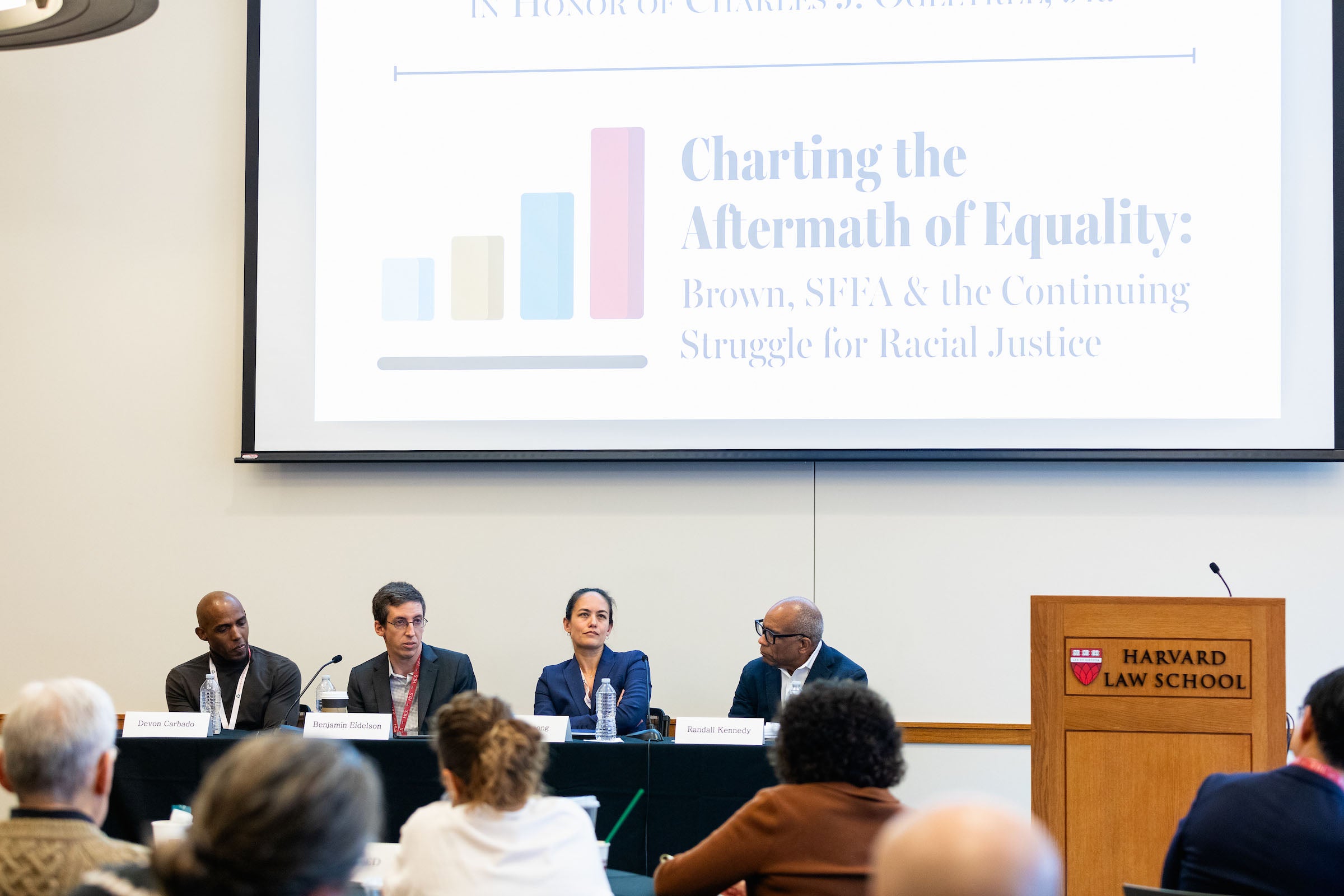

As Carbado sees it, every time advocates for equality seek to take proactive steps to address structural racism, “we encounter … a number of doctrines that get in the way that are built brick by brick.” These include, among others, the Court’s strict scrutiny doctrine; the fact that racial remediation efforts like affirmative action “are framed as racial preferences”; the ways that “societal discrimination is understood to be ‘too amorphous’ to have constitutional eligibility”; and the failure of laws to prevent ‘disparate impact,’ a legal term for facially neutral policies in areas such as housing or employment that nevertheless negatively affect underrepresented minority communities disproportionately.
“So, I tell a story precisely about these doctrinal values, and the relationship between them on the one hand, and structural racism on the other,” Carbado said, referencing his book, “Unreasonable: Black Lives, Police Power, and the Fourth Amendment,” which he smiled and joked to the audience, “you should buy.”
Harvard Law Professor Benjamin Eidelson highlighted what he believes is the Supreme Court’s disjointed approach to the concept of colorblindness. As evidence, he pointed to a passage in Justice Robert’s majority opinion in SFFA v. Harvard that seemed to carve out an exception to the decision’s prohibition against any consideration of race as even one factor among many in admissions decisions by enabling applicants to discuss in their application essays “how race affected his or her life, be it through discrimination, inspiration, or otherwise.” To Eidelson, that sounds like a tacit acknowledgement that race still plays a role in the otherwise colorblind world the Court says it sees.
“They have no coherent conception of when the acknowledgement of the social reality of race is okay and when it’s not,” he said. “And so, they’re kind of in a predicament, and … they’re going to need to liquidate some of this and operationalize it. And it seems to me like a very hard problem that doesn’t reflect a coherent conception of equality.”
Sturm College of Law Professor Nancy Leong took a slightly more optimistic tack. While proclaiming herself as not “particularly enthusiastic about [the Court’s] version of equality,” she believes that the ability to describe one’s experience with race in an application essay provides an opening to work within the justices’ stated conception of colorblindness.
“Because the train has left the station, and we’re all on board,” she said, “I want to take … the majority in SFFA, their definition of equality, on its own terms, and to suggest that even within the framework of colorblindness they seem to be implementing … [they] left open opportunities to advance a version of equality that is informed by historical discrimination and structural racism.”
‘This imagined lawn care entrepreneur’
The Supreme Court’s recent predilection for overturning longstanding precedents originally designed to protect the rights of traditionally underrepresented minorities has stunned many observers, particularly on the progressive end of American politics. But according to NYU Law Professor Melissa Murray, the justices’ commitment to providing what they see as equal protection and remediation to disadvantaged members of society is unchanged. It’s just that the people they now view as the most vulnerable is different.
In the day’s keynote address, Murray noted that, “[i]n just the last five years, the Court has overruled extant precedents on issues that range from abortion and jury convictions to property rights and public unions,” and narrowed many others. Many have argued that the conservative majority has abandoned the concept of stare decisis, or deference to prior decisions, to achieve their politically driven ends. While Murray says she doesn’t necessarily disagree, she offered a more nuanced interpretation. In short, she said, a majority of justices believe that decades of Court decisions, beginning in 1953 when Earl Warren became chief justice, have created a new minority class in need of protection.
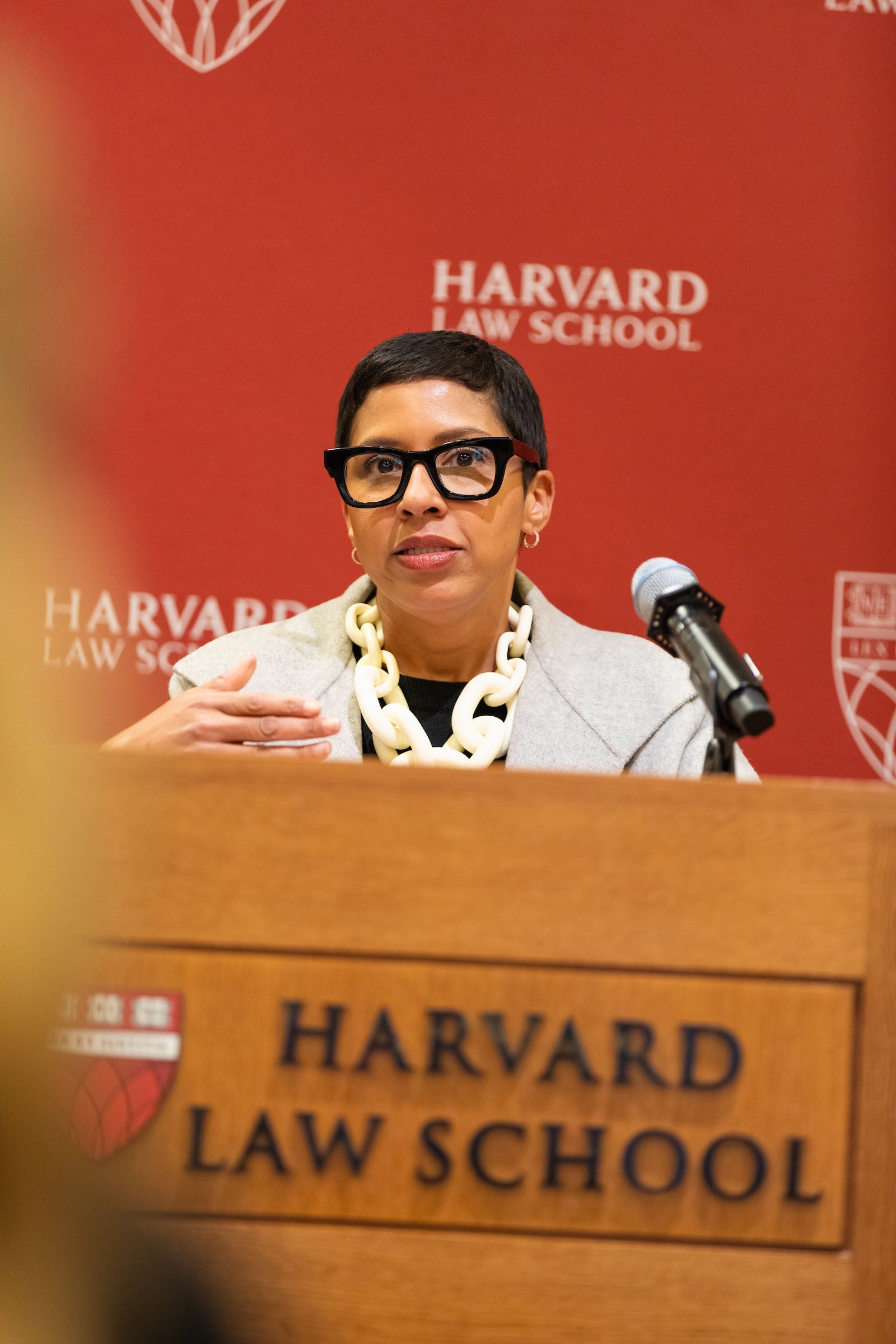
Credit: Lorin Granger
Instead of women or people of color, she said, “the Court’s approach to precedent might reflect an interest in remedying injuries and injustices that are done to other groups, groups that we might not understand as bearing the hallmarks of minority status, but that the Court views as minorities because these groups appear unable to protect themselves against the vicissitudes of the majority. So that begs the question: Who are these new minorities whose interests the Court believes have been subordinated to the preferences of the majority? These groups the Court seems to be in the process of recasting as minorities seem to be Christian conservatives, working class whites, and more generally, white people.”
Murray cited a series of recent First Amendment cases — such as Masterpiece Cakeshop v. Colorado, Espinoza v. Montana Department of Revenue, and 303 Creative LLC v. Elenis, in which the Court sided with religious groups “to expand the scope and substance of the Free Exercise Clause while simultaneously diminishing the force of the Establishment Clause. These doctrinal developments might be understood as responding, at least in part, to a growing sense that majoritarian culture and public policy have left Christian conservatives and evangelicals behind.”
In the decision he authored in Espinosa, for example, in which the Court overturned previous prohibitions against state funding for religious, or sectarian, schools, Chief Justice Roberts claimed, according to Murray, that “it was an open secret that ‘sectarian’ was code for Catholic and that [efforts to prevent state dollars flowing to public schools] share a similarly shameful category of anti-Catholic bias.”
During oral arguments in a case involving the Biden administration’s student debt relief plan, Murray recalled that the Justices Roberts, Amy Coney Barrett, and Samuel Alito “repeatedly raised a hypothetical involving an individual who had not attended college, and instead had started his own lawn care business.”
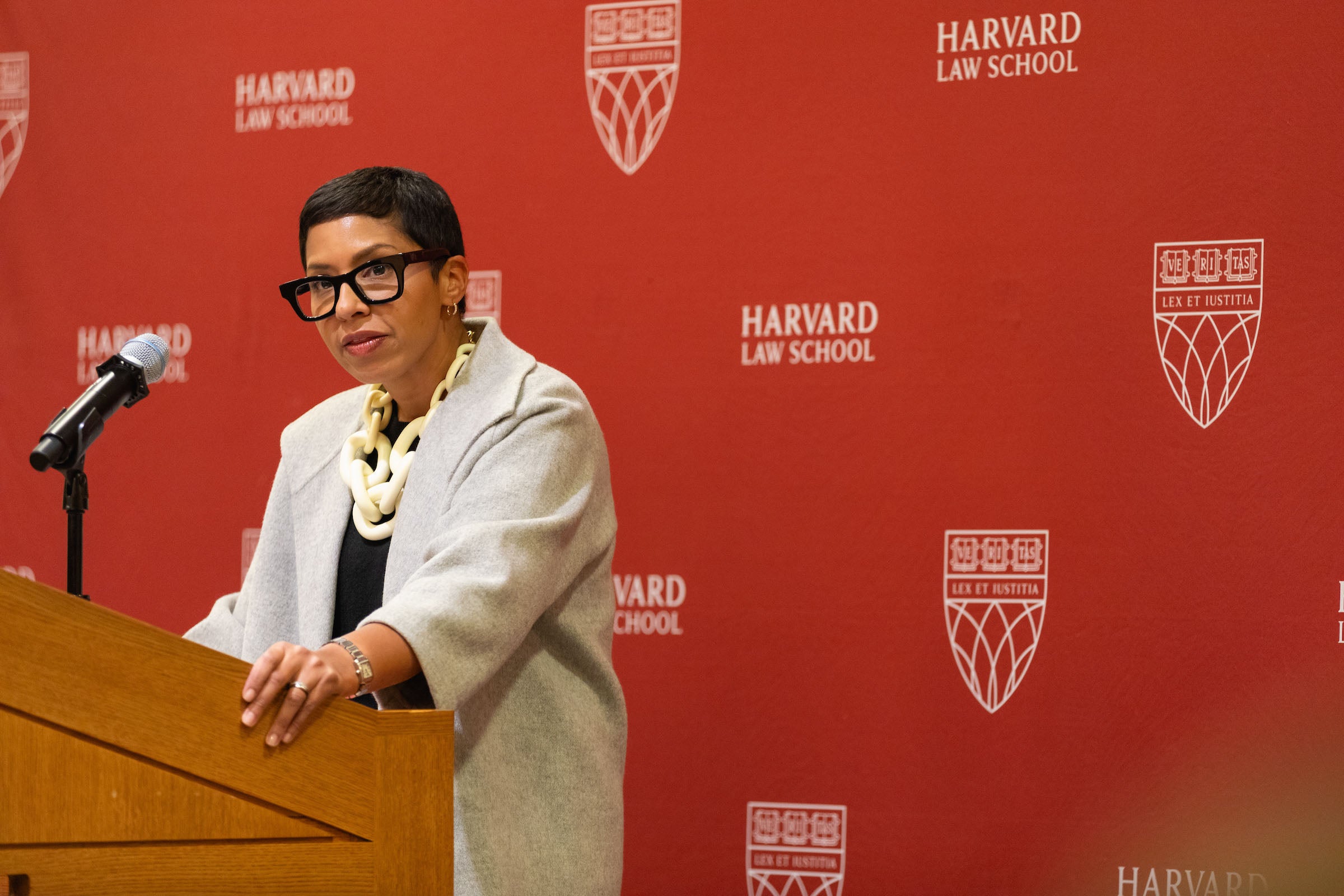
Their concern seemed to be, she said, that “there’s something fundamentally unfair about the government providing millions in relief to higher education borrowers with the student loan relief package, when others, like this imagined lawn care entrepreneur, lacked both the credential of a college degree and the unearned largess of government redistribution in the form of debt relief.” It may not be a coincidence, she hinted, that according to the U.S. Department of Labor, most owners of lawn care companies are white men.
The Court is still attempting to use the Constitution’s Equal Protection Clause to protect and provide redress to minority groups that have been harmed, often by overturning precedents it views as favoring a newly empowered majority, she said.
“The Roberts Court’s remedial approach to stare decisis upends traditional notions of minority status. In the Court’s imagining, there are new minorities who have been displaced by a new cultural landscape that is increasingly secularized and pluralistic,” Murray said. “And critically, it is a cultural landscape that the Court through its earlier decisions on desegregation, abortion, LGBT rights, and civil rights has brought into being and cultivated.”
If the new minority in need of legal protection consists of white, working class, Christians, who does the Court believe are the new majority, Murray asked rhetorically. “Apparently, it is comprised of women, sexual minorities, racial minorities, and other formerly subjugated groups, who now collectively wield outsized influence and power. The members of this new majority … have displaced the old majority with its traditional values, confining it to minority states.”
Murray worries that to rectify this newly perceived imbalance, the justices will continue withdrawing hard-won rights from women, Black and brown people, and the LGBTQ+ community, among others. “The Court’s approach,” she said, “is not simply aimed at remedying past harms. It is also predicated on the view that these new minorities, who were once the majority, should be made whole again, by restoring them to the vaunted social position they once occupied.”
‘Not meant to be some principled act of judging’
During the third panel of the day, Kenneth Mack ’91, Harvard’s Lawrence D. Biele Professor of Law, asked three experts to discuss the path forward.
According to Kevin Brown, a professor of law at the University of South Carolina, a key question focuses on how to “create an empowering perspective and positive framework for understanding the African American experience?” Having spent more than three years abroad across more than 60 trips, he recalled his discovery that “the most negative attitudes in the world about African Americans are the attitudes about us here in the United States. … [W]e are in an extraordinarily toxic environment.”
By contrast, he said, marginalized groups in other nations look up to the African American community as a model for what “oppressed people around the world” can achieve. From the people who make up the caste in India known as the Dalits, previously derided as “untouchables,” to Africans, and African immigrants to the U.S., he said, African Americans are, as a group, held in high esteem. But how can Black people in America see themselves through that same lens? “The answer,” Brown said, “must be international experiences, and a global view of the struggle of Black people in the U.S.”
Advocacy and action are Jonathan Feingold’s preferred paths. An associate professor of law at Boston University and a former community organizer, Feingold said he wants to translate academic symposia into actionable solidarity, mobilizing law professors and others to play both offense and defense. Noting that few in the room likely believed things were ideal or equitable even before the Supreme Court’s recent decisions, Feingold said that “I don’t think offense is to try to get back to where we were, but to use this deep democratic crisis as an opportunity, as law professors, as leaders of academia, to think about how we structure our institutions.”
On the question of defense, he said conference participants must recognize that they are engaging in what he, like Professor Johnson earlier in the day, believes is a political, rather than a strictly legal, struggle. The Supreme Court’s decision to strike down precedents that long permitted the consideration of race as one factor in college admissions is, in Feingold’s telling, “not meant to be some principled act of judging. … The reason why we have SFFA — not Fisher, not Gruder — is not because the ideas got better. It’s because a president changed the composition of his Court,” he said, highlighting two now-overturned precedents.
Rachel F. Moran, a professor of law at Texas A&M University, noted that, in contravention of courts’ general approach to who is allowed to bring a lawsuit, the plaintiff in the affirmative action case was not required to show they’d suffered an injury-in-fact. Instead, the organization was granted standing — the right to sue — based on the presumption that its (never named) members were part of a protected class that had been “stigmatized.”
For Moran, returning to a more traditional notion of standing would be an important step. “It seems to be that there is a very plausible argument that the traditional requirement of actual injury should be reinstated. If that happens … I think it would be very difficult for any particular applicant to show actual injury,” thereby reducing the risk of future litigation for colleges and universities. She believes this approach would appeal to the Court as well, which she suspects “probably doesn’t want to get into the businesses of doing distributive justice.”
‘A focus on class will not insulate reform efforts from challenges’
The afternoon’s final discussion, moderated by Tomiko Brown-Nagin, whose remarks about the legacy of Brown v. Board of Education had opened the day, focused on efforts to reform education to achieve equal access without considering the race of applicants in the admissions process.
University of Virginia Law Professor Kimberly Robinson ’96 described America’s relationship with the racially segregated era of Jim Crow as a love affair that the U.S. has tried, but so far failed, to end.
“We’ve all experienced different types of breakups,” she said, describing the experience as ranging from, on one end of the spectrum, a “longing breakup” in which you stay in touch, hold on to keepsakes, and pine for the possibility of getting back together and, on the other end, the “scorched earth” approach. America’s liaison with Jim Crow is more like the former than the latter, she believes. “I would argue that we need to truly end that relationship.”
One tool for doing so, Robinson argued, is for Congress to create a federal right to education, much as it did in 1990 when lawmakers approved the Individuals with Disabilities Education Act, requiring local school districts to provide special education plans for children with learning or other difficulties. One benefit of congressional action, she said, would be the creation of a nationwide minimum standard for guaranteeing equal educational opportunity below which individual states could not go.
Another potential tool, Robinson maintained, is stronger enforcement of existing statutes that prohibit discrimination or the denial of benefits based on race, color, or national origin in any program funded with federal dollars, as almost all local public schools are.
“Setting aside the need for new laws,” she explained, “Title VI of the Civil Rights Act doesn’t just prohibit intentional discrimination. The regulations under the Department of Education prohibit schools from having neutral policies or practices that have a disparate impact.”
Unfortunately, most school districts, Robinson believes, don’t know that. “They simply think that as long as they don’t intend to harm someone, they can … take whatever action they choose to and believe is educationally best. And they’re not really filtering their work through this disparate impact lens, even though the federal regulations that they agreed to abide by when they took the federal money require them to do so.”
George Washington University’s Richard Kahlenberg ’89, a longtime proponent of using economic class as a filter for college admissions, and Osamudia James of the University of North Carolina School of Law, both decried a dissent issued by Justices Alito and Clarence Thomas in a case centered on the admissions policies of a magnet high school in northern Virginia.
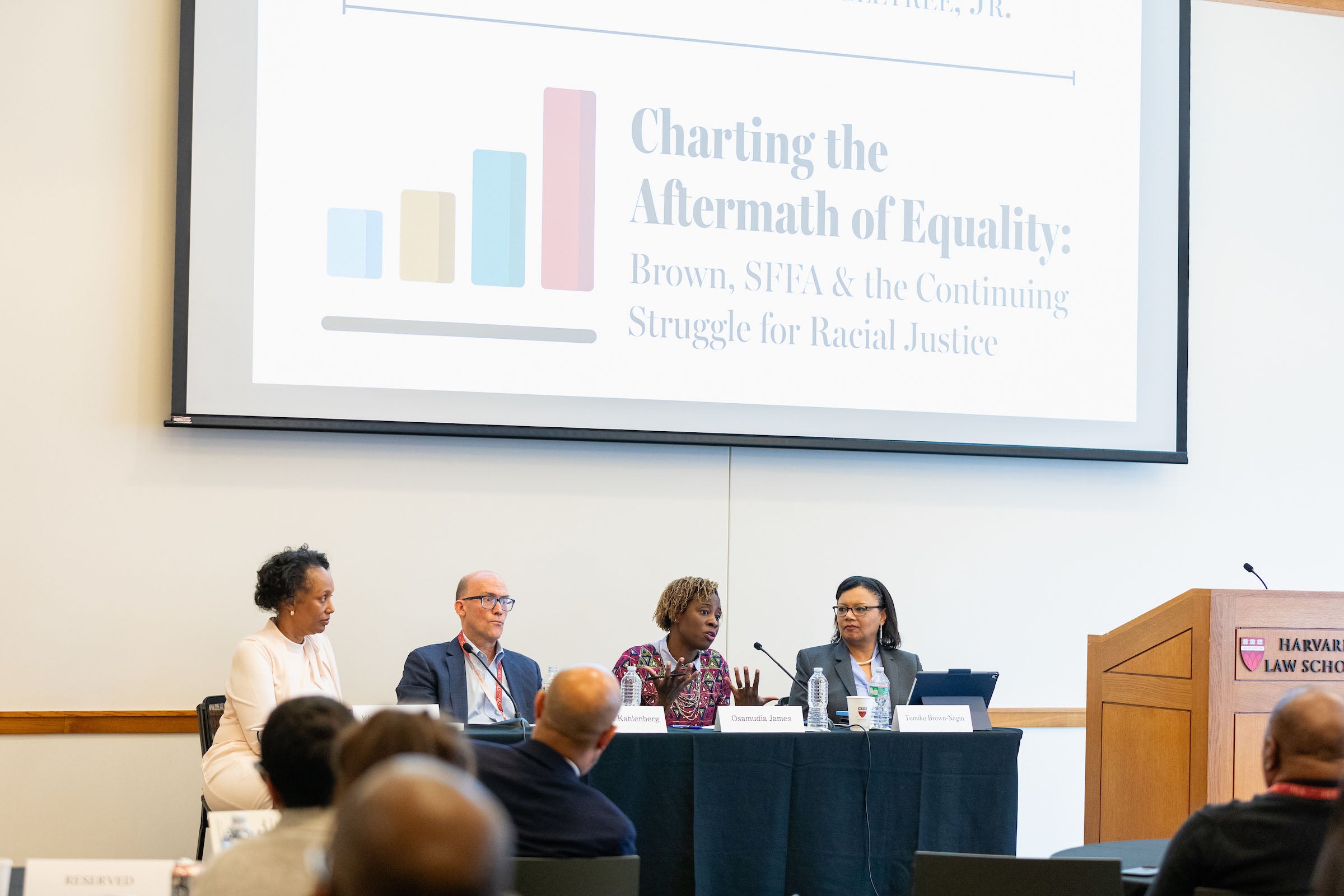
In February, a majority of the justices choose not to hear the appeal of a lower court’s ruling that Thomas Jefferson High School’s new approach to admitting students was constitutional, even though it resulted in a decrease in the number of admitted Asian American students. Instead of using race as a consideration, the school simply admitted the top 1.5% of each regional middle school’s 8th grade class. Under this new system, admissions rates for Black and Hispanic students, as well as females, increased. And although rates for Asian American students dropped from previous highs, the group was still overrepresented when compared to their proportion of the population.
But this decrease, and their colleagues’ choice not to examine and sanction it, drew a stinging rebuke from two of the most conservative justices, who called it “flagrantly wrong,” “indefensible,” and “a virus that may spread if not promptly eliminated.”
“I was appalled that Alito and Thomas, who had been advocating for race neutral strategies for decades,” said Kahlenberg, are now seemingly “disavowing” their previously stated beliefs.
James took the point even further, saying that “[o]pposition to race conscious admissions policies has until now been reportedly anchored in the desire for race neutral attempts to broaden access.” While Kahlenberg and many conservative analysts and jurists have long argued that class was a more egalitarian way to achieve educational equality than even the most marginal consideration of race, several recent events, including Alito and Thomas’ dissent from the Court’s February decision not to review the lower court’s judgment in the Thomas Jefferson High School case, she argued, “illustrate that a focus on class will not insulate reform efforts from challenges.”
“Class-informed plans responsive in part, as they necessarily must be, to racial disparities will be challenged as racial discrimination,” James said. “School boards, administrators, policymakers, honest enough to acknowledge the connections between race and class disparities will have their observations used against them in litigation. … And even those admissions policies that produce economic, demographic, and gender diversity in addition to racial diversity may not pass muster if a claim of intentional discrimination or even just disparate impact is made.”
‘Don’t shout too soon’
In closing remarks, Harvard’s Kenneth Mack ’91, who earlier moderated the day’s third panel, argued that the stakes of the ongoing debate go well beyond admissions policies at elite educational institutions. Rather, he believes, “the attack on what are termed ‘racial preferences’” touches on every aspect of American life in which underrepresented minority communities have made, or are attempting to make, gains towards equal representation.
“There’s been an attack on teaching students at all levels of education anything that has to do with race,” he said. “There has been an attack on what we might call DEI [diversity, equity and inclusion], although DEI is a catch-all phrase that encompasses many, many things. And we should not forget that our symposium takes place in the wake of an attack on Black voting rights.”

More broadly, Mack argued, employment and economic opportunity are also in play. “We should recall that the roots of affirmative action are not admission to elite universities like this one,” he said. “The roots of affirmative action are in employment.” The concept, he explained, originated during the 1930s as part of the New Deal and was revived in the 1960s. So, he said, “we should understand the stakes of our moment, or the context in which our conference gathers, as, in fact, an attack on the … role of race in basic things that everyday Americans need to participate in the life of our society — not only schooling, but employment, voting, and many other things.”
Mack concluded the day by reminding conference participants of the title of a 1936 article written by Charles Hamilton Houston ’1922 S.J.D. ’1923, the civil rights lawyer and namesake of the institute at Harvard Law that helped organize the symposium. Houston had just convinced the Maryland Court of Appeals to order the University of Maryland Law School to admit Donald G. Murray, a Black man, if his application otherwise qualified him to attend. Murray became the school’s first African American student and graduate.
Shortly after this success, Houston wrote in an article titled “Don’t Shout Too Soon,” that despite the recent victory, “the walls of prejudice are not going to tumble down just because the Court of Appeals issued its solemn pronouncement.”
Mack urged the audience to heed Houston’s admonition. “So, I do hope that as we go out from this conference, and we do the intellectual, the advocacy, and the other work, the inspirational work, the political work that needs to be done to respond to all the needs of our moment … that [we] keep those words in mind,” Mack concluded.
Want to stay up to date with Harvard Law Today? Sign up for our weekly newsletter.
